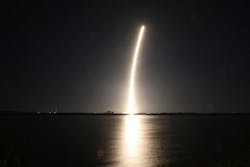Firefly Aerospace's commercial lunar mission en route to the Moon
CAPE CANAVERAL, Fla. - The National Aeronautics and Space Administration (NASA) announced that scientific instruments and technology demonstrations are headed to the Moon as part of Firefly Aerospace’s Blue Ghost Mission 1, the company’s first Commercial Lunar Payload Services (CLPS) flight. The spacecraft lifted off at 1:11 a.m. EST on 15 January aboard a SpaceX Falcon 9 rocket from Kennedy Space Center in Florida and is expected to land on the Moon on 2 March.
"This mission embodies the bold spirit of NASA's Artemis campaign," said NASA Deputy Administrator Pam Melroy. "Each scientific instrument and technology demonstration brings us closer to realizing our vision."
The mission carries 10 NASA payloads designed to test technologies and study the lunar environment. These include tools for drilling and collecting lunar regolith, radiation-tolerant computing, dust mitigation, and global navigation using Earth-based satellite systems. Other experiments will measure the Moon's thermal properties, study its magnetic and electric fields, and investigate how rocket plumes affect lunar soil.
Related: NRO selects Firefly Aerospace as a commercial launch partner
The lander is targeted to touch down near Mons Latreille in Mare Crisium, a 300-mile-wide basin. This is the largest CLPS delivery to date, according to NASA, which plans more lunar payload deliveries in the coming years to support the Artemis program and eventual human missions to Mars.
Lunar Instrumentation for Subsurface Thermal Exploration with Rapidity (LISTER) will characterize heat flow from the interior of the Moon by measuring the thermal gradient and conductivity of the lunar subsurface. It will take several measurements to about a 10-foot final depth using pneumatic drilling technology with a custom heat flow needle instrument at its tip. Lead organization: Texas Tech University
Lunar PlanetVac (LPV) is designed to collect regolith samples from the lunar surface using a burst of compressed gas to drive the regolith into a sample chamber for collection and analysis by various instruments. Additional instrumentation will then transmit the results back to Earth. Lead organization: Honeybee Robotics
Next Generation Lunar Retroreflector (NGLR) serves as a target for lasers on Earth to precisely measure the distance between Earth and the Moon. The retroreflector that will fly on this mission could also collect data to understand various aspects of the lunar interior and address fundamental physics questions. Lead organization: University of Maryland
Related: NASA announces NIAC program funding awardees
Regolith Adherence Characterization (RAC) will determine how lunar regolith sticks to a range of materials exposed to the Moon's environment throughout the lunar day. The RAC instrument will measure accumulation rates of lunar regolith on the surfaces of several materials including solar cells, optical systems, coatings, and sensors through imaging to determine their ability to repel or shed lunar dust. The data captured will allow the industry to test, improve, and protect spacecraft, spacesuits, and habitats from abrasive regolith. Lead organization: Aegis Aerospace
Radiation Tolerant Computer (RadPC) will demonstrate a computer that can recover from faults caused by ionizing radiation. Several RadPC prototypes have been tested aboard the International Space Station and Earth-orbiting satellites, but now will demonstrate the computer's ability to withstand space radiation as it passes through Earth's radiation belts, while in transit to the Moon, and on the lunar surface. Lead organization: Montana State University
Electrodynamic Dust Shield (EDS) is an active dust mitigation technology that uses electric fields to move and prevent hazardous lunar dust accumulation on surfaces. The EDS technology is designed to lift, transport, and remove particles from surfaces with no moving parts. Multiple tests will demonstrate the feasibility of the self-cleaning glasses and thermal radiator surfaces on the Moon. In the event the surfaces do not receive dust during landing, EDS has the capability to re-dust itself using the same technology. Lead organization: NASA's Kennedy Space Center
Related: NASA to test rad-tolerant computing solution for space
Lunar Environment heliospheric X-ray Imager (LEXI) will capture a series of X-ray images to study the interaction of solar wind and the Earth's magnetic field that drives geomagnetic disturbances and storms. Deployed and operated on the lunar surface, this instrument will provide the first global images showing the edge of Earth's magnetic field for critical insights into how space weather and other cosmic forces surrounding our planet impact it. Lead organizations: NASA's Goddard Space Flight Center, Boston University, and Johns Hopkins University
Lunar Magnetotelluric Sounder (LMS) will characterize the structure and composition of the Moon's mantle by measuring electric and magnetic fields. This investigation will help determine the Moon's temperature structure and thermal evolution to understand how the Moon has cooled and chemically differentiated since it formed. Lead organization: Southwest Research Institute
Lunar GNSS Receiver Experiment (LuGRE) will demonstrate the possibility of acquiring and tracking signals from Global Navigation Satellite System constellations, specifically GPS and Galileo, during transit to the Moon, during lunar orbit, and on the lunar surface. If successful, LuGRE will be the first pathfinder for future lunar spacecraft to use existing Earth-based navigation constellations to autonomously and accurately estimate their position, velocity, and time. Lead organizations: NASA Goddard, Italian Space Agency
Stereo Camera for Lunar Plume-Surface Studies (SCALPSS) will use stereo imaging photogrammetry to capture the impact of rocket plume on lunar regolith as the lander descends on the Moon's surface. The high-resolution stereo images will aid in creating models to predict lunar regolith erosion, which is an important task as bigger, heavier payloads are delivered to the Moon in close proximity to each other. This instrument also flew on Intuitive Machine's first CLPS delivery. Lead organization: NASA's Langley Research Center
